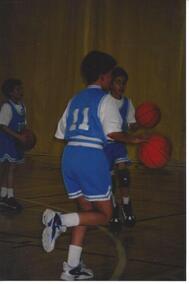
I’m a sports fan. I’m not sure I’m the stereotypical fan, but I am a fan. I don’t have one absolute favourite sport I follow, but I do appreciate sport and the athleticism and commitment it takes to be at the top of one’s game. I love watching playoffs in almost any sport and when the Olympics are being broadcast, I’m a fan of everything.
I’ve coached quite a few teams over the years. I didn’t ever start out as an expert, and truth be told, I never finished as an expert either. But whether coaching soccer, cross country, basketball or track and field, I loved taking coaching courses and certifications, and I loved to learn not only about the game but about what made the players tick.
One part of coaching that is always challenging is assessing which players to have on the court, field, or track at any given time. The coach needs to be able to figure out which players are ‘on their game’, which ones play well together on a lineup, which ones needs a little pep talk or reminder of a play, and which players need to sit on the sidelines for a bit. In my experience, no player liked the sideline, but most of them benefited from it at some point.
The reasons for taking a player out of a game, for sidelining them, can be complex. But really, it boils down to this: if a player is unable to execute what the coach has asked for and what the team needs, they are asked to step away from the game, figure out what adjustment needs to be made to their play, and then wait to get back in for another chance. This happens in all sports, to all players. Sometimes it is the coach who has the advice the player needs, other times the player uses their introspection to figure things out for themselves. The great players are able to make such adjustments quickly and without taking things too personally.
When I was coaching and would remove a player from play, before returning them to the activity, I’d check to make sure they had figured out what they needed to know to be more successful the next shift. The goal was always to have the player re-enter the game feeling like they could be more successful, and that they had more insight into their own game. It’s never nice to be on the sidelines, but there is nothing quite as sweet as returning to a game feeling, and playing with more confidence and purpose.
These days, we’ve all been moved to the edges of the game we love, the game of life. We’ve been taken out of our game, and are stuck on the sidelines watching. We watch through Zoom, through Facetime, through television, videos, YouTube and any other form of visual medium available. Most of us want to shout, ‘Put me in, coach! I’m ready to go back.’ Unfortunately, while soon we will likely be put back into the game, this is one time the coach is not going to tell us what to do when we do go back. That would be far too easy. Oh, we will have ‘coaches’ tell us some of the mechanics we will need; things like how many people can be in a restaurant at a time, whether to wear a mask or not, when it might be safe to hug and when we can gather to watch professional sports. But the real learning will come from within each of us. As we sit on our sideline, we each have some soul searching to do to decide what our game will look like when we re-enter. We each need to figure out if what we were doing pre-pandemic was working best for our own game.
There is very little I have liked about the restrictions we have all faced during this pandemic. I do appreciate the need for the restrictions, and I have been very willing to be compliant. But I don’t like it. What I have come to appreciate, though, is the time I’ve had to sit on the sidelines, to think about my game, and to decide which parts of it I’m happy with, and which parts need some adjustment. I’ve had time to think about which line I play best on, and which line I really don’t need to play on at all. I’ve had time to think about how my actions impact others, either helping them with their game, or not. I’ve had time to think about the impact others have on me. I’ve had time to think about the position I’ve been willing to play, and whether I want to try out for a new position or keep the one familiar to me. I’ve had time to think about what I will be saying yes to, and what things I can leave for others.
Players have to trust coaches to put them back in to the game at the right time. Right now, while we say, ‘Put me in Coach!’, we also know our sitting time might last a bit longer. When we do get the tap on the shoulder, may each of us be ready to return to play our best game.
My inquiry for you this week is, ‘Where does this fit in my best game?’
Elizabeth is a certified professional Leadership Coach, and the owner of Critchley Coaching. She is the founder and president of the Canadian charity, RDL Building Hope Society. She works with corporations, non-profits and the public sector, providing leadership coaching. She creates and facilitates custom workshops for all sizes of groups. She has particular expertise in facilitating Strategic Plans for organizations. Contact Elizabeth to learn how to maximize your time on the sideline.


 RSS Feed
RSS Feed